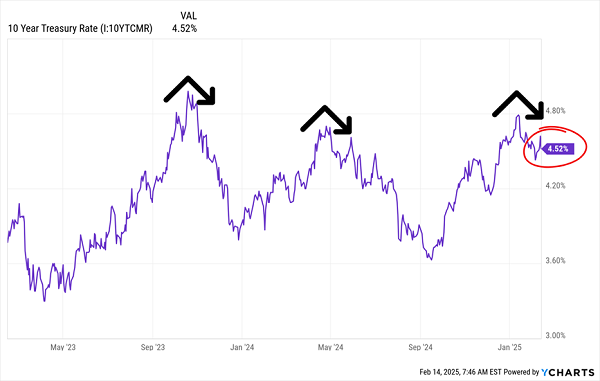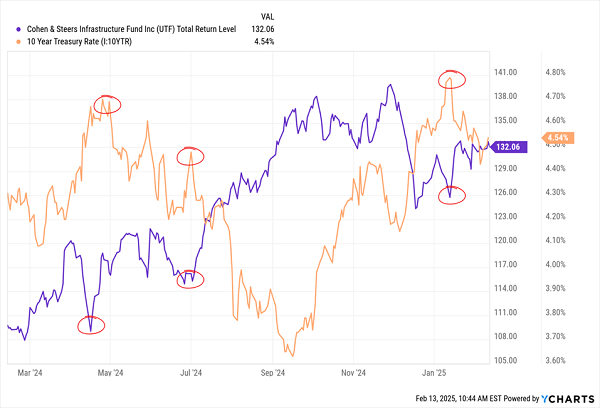Bonds (and bond proxies) are hated right now. That’s our shot at big dividends—because mainstream investors’ thinking here is totally backward.
We’re going to pounce, and use this opportunity to grab ourselves a huge 7.6% payout sporting an unusual “discount in disguise.”
Tariffs: Don’t Believe the Hype
The reason for this opportunity comes back to tariffs—which I admit, dear reader, I’ve heard so much about that I’m starting to dream about them at night!
The badly flawed logic most people are applying to tariffs is this: Tariffs will drive up prices, adding to an inflation rate that, according to last week’s CPI report, hit 3% year over year, up from 2.9% the month before and a mere 2.4% in October (and was ahead of expectations, to boot).
Here’s where that logic goes off the rails, though. We’ve been talking tariffs pretty much non-stop since November when then-President-Elect Trump called for 25% duties on Canadian and Mexican imports concerning border security.
Those have been put on ice for now. But are still very much alive.
Then there are 25% tariffs on steel and aluminium from all countries, announced on Super Bowl Sunday and set to come in on March 12. And finally, we have the so-called “reciprocal tariffs” announced last Thursday (details are apparently forthcoming).
One thing we can be sure of is this will be an ongoing thing with Trump, who has been talking about tariffs since 1989 when he advocated for a 15% to 20% tariff on imports from Japan because of unfair trade practices.
But here’s where things get interesting: If the common “wisdom” on tariffs were true, we’d expect the 10-year Treasury yield (the benchmark for most consumer and business loans) to soar, right?
Well, it initially popped up on last week’s hot CPI number. Then it did what it’s done over and over for the last few years: It “hit its head” on a new recent peak and dropped. It remains below the 5% level, where it’s hit the most resistance.
Bond Market Knows the Truth About Tariffs

If the bond market were worried about tariffs spiking inflation, you’d expect the 10-year rate to break out. Instead, the opposite has happened.
That’s because, contrary to popular belief that these levies are inflationary, a recent study shows otherwise. The Centre for Economic Policy Research found that tariffs do not boost inflation because rising prices depend on a hot economy—and a trade war brings in the opposite since tariffs are a short-term headwind on growth.
The Financial Times recently reached a similar conclusion. Yes, tariffs compress company margins due to upward wage pressure and higher costs. But these are typically absorbed by the firms—and their shareholders!
All of this sets up a buy window for us in bonds (and bond proxies)!
Today we’re dipping into our Contrarian Income Report portfolio’s bucket of utilities, specifically a CEF—with a 7.6% yield in this case: the Cohen & Steers Infrastructure Fund (NYSE:UTF).
You don’t have to squint hard to see that when the 10-year yield pops, it’s a great time to buy this fund. And with last week’s “bounce-and-plunge” in said yield, we’ve got another good opportunity to get in—especially if, as I expect, the 10-year yield falls more than expected on a slowing economy:
Bond Proxy UTF Is a Smart “Rinse-and-Repeat” Trade on the 10-Year

UTF is my “go-to” ticker for utility stocks. As mentioned, it pays 7.6% and gives us instant exposure to 256 strong utility names, including American Tower (NYSE:AMT), the Southern Company (NYSE:SO) and Duke Energy (NYSE:DUK). About 34% of its portfolio is in electric utilities. It also holds 16% in corporate bonds (another part of the reason for the correlation with the 10-year Treasury yield) and 11% in pipelines.
Sometimes we’re fortunate enough to be able to buy UTF at a discount to its net asset value (NAV, or the value of its underlying portfolio). Today, it trades near par. We’ll take UTF anytime it’s near par (or below) because its NAV will gain as rates decline.
Disclosure: Brett Owens and Michael Foster are contrarian income investors who look for undervalued stocks/funds across the U.S. markets. Click here to learn how to profit from their strategies in the latest report, "7 Great Dividend Growth Stocks for a Secure Retirement."
